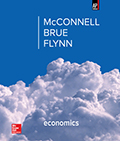Economics (McConnell), AP* Edition, 20th EditionChapter 30:
Aggregate Demand and Aggregate Supply (+ Appendix) After studying this chapter, you should be able to: LO 30.1 | Define aggregate demand (AD) and explain how its downward slope is the result of the real-balances effect, the interest-rate effect, and the foreign purchases effect. | LO 30.2 | Explain the factors that cause changes (shifts) in AD. | LO 30.3 | Define aggregate supply (AS) and explain how it differs in the immediate short run, the short run, and the long run. | LO 30.4 | Explain the factors that cause changes (shifts) in AS. | LO 30.5 | Discuss how AD and AS determine an economy's equilibrium price level and level of real GDP. | LO 30.6 | Describe how the AD-AS model explains periods of demand-pull inflation, cost-push inflation, and recession. | LO 30.7 | (Appendix) Identify how the aggregate demand curve relates to the aggregate expenditures model. |
 | 




